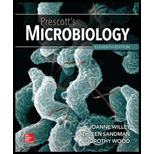
Prescott's Microbiology
11th Edition
ISBN: 9781260409062
Author: WILLEY, Joanne
Publisher: MCGRAW-HILL HIGHER EDUCATION
expand_more
expand_more
format_list_bulleted
Concept explainers
Question
Chapter 2.3, Problem 1CC
Summary Introduction
The most fundamental reason for staining the sample is to improve the visualization of cell’s components or the cell. In some cases, staining is used for highlighting the
Expert Solution & Answer
Want to see the full answer?
Check out a sample textbook solution
Students have asked these similar questions
Sippose your unknown bacteria is a Gram-negative rod. You decide to perform an endospore stain, thinking it will help you with the identification of the organism. What will you see and why?
Outline all the factors needs to consider when performing agarose gel-based electrophoresis
Explain the concept of UV unwrapping and its importance in texturing 3D models.
Chapter 2 Solutions
Prescott's Microbiology
Ch. 2.1 - Prob. 1MICh. 2.1 - Prob. 1CCCh. 2.1 - Prob. 2CCCh. 2.1 - Prob. 3CCCh. 2.2 - Prob. 1MICh. 2.2 - Prob. 2MICh. 2.2 - Prob. 3MICh. 2.2 - Prob. 1CCCh. 2.2 - Prob. 2CCCh. 2.2 - Prob. 3CC
Ch. 2.2 - Prob. 4CCCh. 2.2 - Prob. 5CCCh. 2.2 - Prob. 6CCCh. 2.3 - Prob. 1MICh. 2.3 - Prob. 1CCCh. 2.3 - Retrieve, Infer, Apply 2. Why would basic dyes be...Ch. 2.3 - Prob. 3CCCh. 2.3 - Prob. 4CCCh. 2.4 - Prob. 1MICh. 2.4 - Prob. 1CCCh. 2.4 - Prob. 2CCCh. 2.4 - Prob. 3CCCh. 2.4 - Prob. 4CCCh. 2.5 - Prob. 1MICh. 2.5 - Prob. 1CCCh. 2.5 - Prob. 2CCCh. 2 - Prob. 1RCCh. 2 - Prob. 2RCCh. 2 - Prob. 3RCCh. 2 - Prob. 1ALCh. 2 - Prob. 2ALCh. 2 - Prob. 4AL
Knowledge Booster
Learn more about
Need a deep-dive on the concept behind this application? Look no further. Learn more about this topic, biology and related others by exploring similar questions and additional content below.Similar questions
- Q6. Why do Gram positive bacteria stain differently to Gram negative bacteria using the Gram stain? .....arrow_forwardSimple Stain What is the difference between simple stain and complex stain? Describe the color of an S. aureus after performing simple stain with Safranin Red. Why? What do you conclude after performing simple stain and observing “Purple cells longer than they are widearrow_forward.What distinguishes Acid-Fast bacteria in terms of cell wall / coating and other characteristics? Describe the stages involved in acid fast staining following heat fixation. Acid fast staining is commonly used in which bacteria?arrow_forward
- Identify the shapes and arrangements of the following bacteria observed under the microscope. Recall: look for the arrangement seen with most cells; you may see another arrangement that is less common. option: spirillum, strepto, positive, bacillus, staphylo, negative, diplo Cell shape ? Gram stain ? Cell arrangement ?arrow_forwardExplain the mechanisms of the four types of fluorescence microscopy we discussed in lab: 1) GFP fusion proteins 2) immunofluorescence - direct and indirect, 3) mitotracker, and 4) phalloidin.arrow_forwardMicrobiologyarrow_forward
- Identify the shapes and arrangements of the following bacteria observed under the microscope. Recall: look for the arrangement seen with most cells; you may see another arrangement that is less common. option: coccus, spirillum, negative, strepto, single, positive Gram Stain ? Cell Shape ? Cell arrangement ?arrow_forwardIllustrated Diagram: Make an illustrated diagram of a stepwise procedure for the performance of simple staining and gram staining. 1. Simple Stainingarrow_forwardWhat is the application of Gel Electrophoresis in healthcare? Cite at least 2 specific examples.arrow_forward
- Q10) What genera produce endospores? - What culture would have more endospores? A bacterium in broth culture for 24 hour or 72 hours? - How specifically does a flagella stain let us see the flagella? (they’re too thin to be seen with 1000X magnification)arrow_forwardMicrobiologyarrow_forwardHow to properly handle a Microscope? Explain. Thank you.arrow_forward
arrow_back_ios
SEE MORE QUESTIONS
arrow_forward_ios
Recommended textbooks for you
 Human Anatomy & Physiology (11th Edition)BiologyISBN:9780134580999Author:Elaine N. Marieb, Katja N. HoehnPublisher:PEARSON
Human Anatomy & Physiology (11th Edition)BiologyISBN:9780134580999Author:Elaine N. Marieb, Katja N. HoehnPublisher:PEARSON Biology 2eBiologyISBN:9781947172517Author:Matthew Douglas, Jung Choi, Mary Ann ClarkPublisher:OpenStax
Biology 2eBiologyISBN:9781947172517Author:Matthew Douglas, Jung Choi, Mary Ann ClarkPublisher:OpenStax Anatomy & PhysiologyBiologyISBN:9781259398629Author:McKinley, Michael P., O'loughlin, Valerie Dean, Bidle, Theresa StouterPublisher:Mcgraw Hill Education,
Anatomy & PhysiologyBiologyISBN:9781259398629Author:McKinley, Michael P., O'loughlin, Valerie Dean, Bidle, Theresa StouterPublisher:Mcgraw Hill Education, Molecular Biology of the Cell (Sixth Edition)BiologyISBN:9780815344322Author:Bruce Alberts, Alexander D. Johnson, Julian Lewis, David Morgan, Martin Raff, Keith Roberts, Peter WalterPublisher:W. W. Norton & Company
Molecular Biology of the Cell (Sixth Edition)BiologyISBN:9780815344322Author:Bruce Alberts, Alexander D. Johnson, Julian Lewis, David Morgan, Martin Raff, Keith Roberts, Peter WalterPublisher:W. W. Norton & Company Laboratory Manual For Human Anatomy & PhysiologyBiologyISBN:9781260159363Author:Martin, Terry R., Prentice-craver, CynthiaPublisher:McGraw-Hill Publishing Co.
Laboratory Manual For Human Anatomy & PhysiologyBiologyISBN:9781260159363Author:Martin, Terry R., Prentice-craver, CynthiaPublisher:McGraw-Hill Publishing Co. Inquiry Into Life (16th Edition)BiologyISBN:9781260231700Author:Sylvia S. Mader, Michael WindelspechtPublisher:McGraw Hill Education
Inquiry Into Life (16th Edition)BiologyISBN:9781260231700Author:Sylvia S. Mader, Michael WindelspechtPublisher:McGraw Hill Education

Human Anatomy & Physiology (11th Edition)
Biology
ISBN:9780134580999
Author:Elaine N. Marieb, Katja N. Hoehn
Publisher:PEARSON

Biology 2e
Biology
ISBN:9781947172517
Author:Matthew Douglas, Jung Choi, Mary Ann Clark
Publisher:OpenStax

Anatomy & Physiology
Biology
ISBN:9781259398629
Author:McKinley, Michael P., O'loughlin, Valerie Dean, Bidle, Theresa Stouter
Publisher:Mcgraw Hill Education,

Molecular Biology of the Cell (Sixth Edition)
Biology
ISBN:9780815344322
Author:Bruce Alberts, Alexander D. Johnson, Julian Lewis, David Morgan, Martin Raff, Keith Roberts, Peter Walter
Publisher:W. W. Norton & Company

Laboratory Manual For Human Anatomy & Physiology
Biology
ISBN:9781260159363
Author:Martin, Terry R., Prentice-craver, Cynthia
Publisher:McGraw-Hill Publishing Co.

Inquiry Into Life (16th Edition)
Biology
ISBN:9781260231700
Author:Sylvia S. Mader, Michael Windelspecht
Publisher:McGraw Hill Education